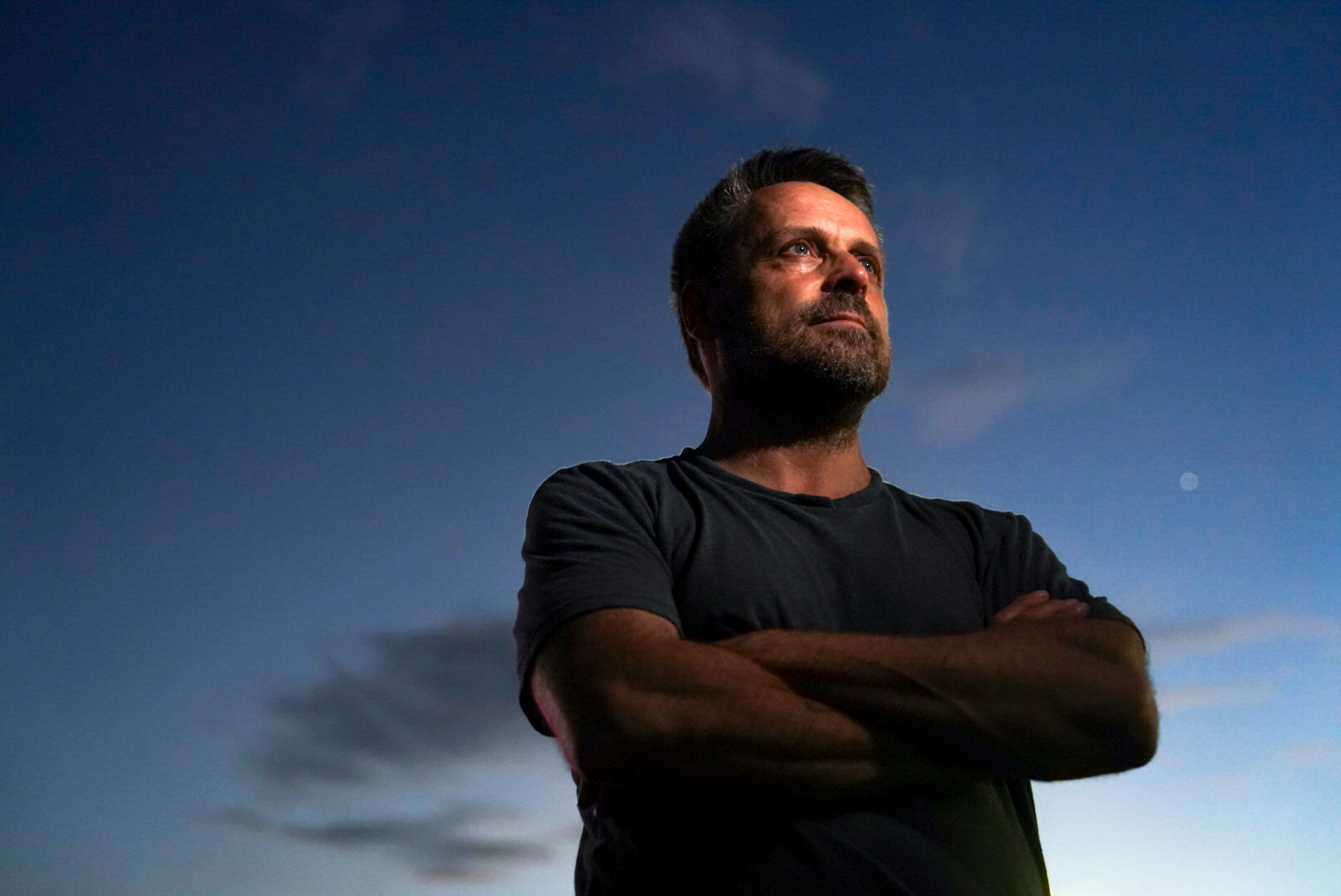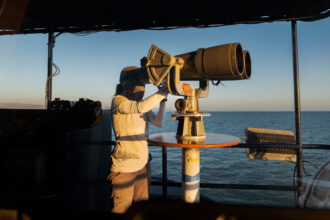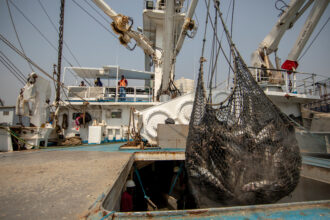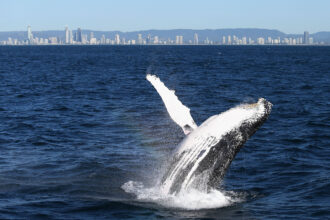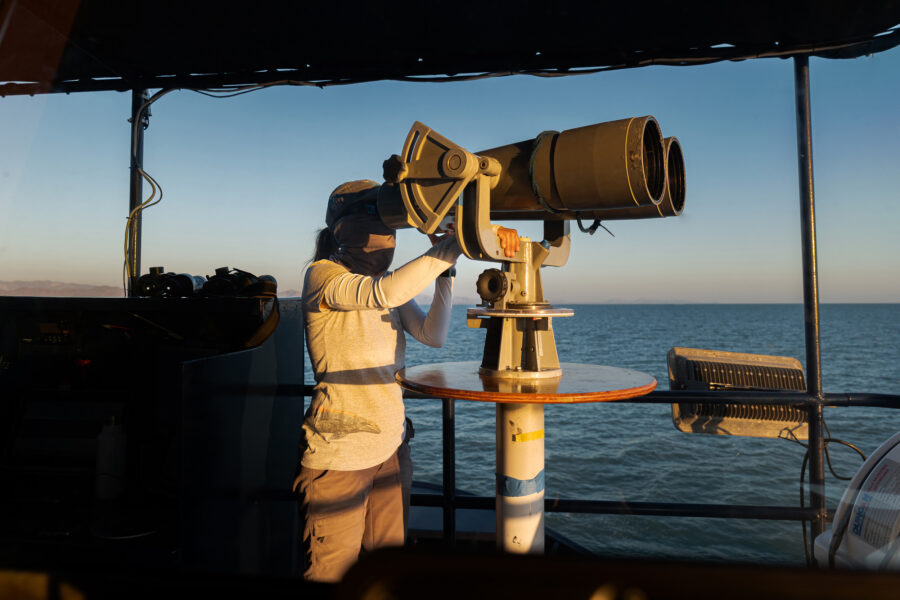In Mexico’s Upper Gulf of California, a lucrative and deadly wildlife trade continues to threaten the survival of the world’s most endangered marine mammal—the vaquita porpoise. At the center of this crisis is the totoaba, a large, endangered fish whose swim bladder is prized in traditional Chinese medicine for its purported health benefits. Some of these bladders can sell for tens of thousands of dollars in illicit markets, sustaining a transnational supply chain of poachers, traffickers, and buyers that spans Mexico, the United States and various countries in Asia.
To catch totoaba, which can grow more than six feet long and weigh up to 300 pounds, fishermen use large-mesh gillnets designed to ensnare the fish by their gills as they swim through. But these same nets also trap and kill vaquitas and other marine life. In an attempt to protect both species, Mexico banned the totoaba fishery in the 1970s. Soon after, the Convention on International Trade in Endangered Species of Wild Fauna and Flora (CITES) also instated a ban on the international trade of the endangered fish. Yet despite decades of protection, the illegal totoaba fishery continues, fueled by staggering profits and persistent global demand.
Around 2012, biologist Lorenzo Rojas-Bracho, from Mexico’s National Commission of Protected Natural Areas (CONANP), said he remembers clearly when the totoaba trade really took off. “We had a call from a fisherman and friends in the upper Gulf telling us, you know, there’s something strange happening here. There’s a bunch of young fishermen with tons of money, and so we’re not sure, but it seems they are getting very well paid for totoaba.”
One fisherman, he said, revealed he was paid $10,000 for two pounds of the fish’s swim bladder, known in Mexico as buche. Another one, Rojas-Bracho said, claimed to have made more than $100,000 in a single day of totoaba fishing. “So that amount of money that a fisherman couldn’t see in years, suddenly there was with the totoaba,” said Rojas-Bracho.
But the fishermen, he added, are only one part of a much larger network involved in the totoaba trade, which he emphasized is not only an environmental issue, but an “international financial crime.”
To combat this activity, Mexican officials say they are working closely with all countries involved.
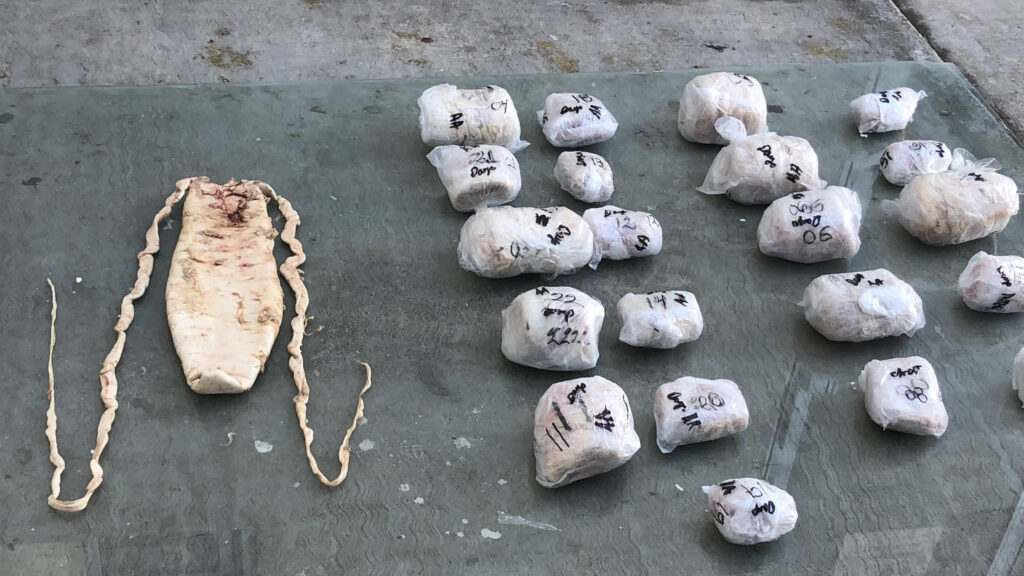
“The consumption of totoaba swim bladders doesn’t occur in Mexico,” said Marina Robles García, undersecretary of biodiversity and environmental restoration at Mexico’s Secretariat of Environment and Natural Resources (SEMARNAT), a federal agency responsible for overseeing the country’s environmental policy. “The transit of totoaba swim bladders involves other countries, including the United States, China, and even Canada, which is why coordination with these countries is so important for us to succeed,” she said, speaking at a press conference in Mexico about the latest annual vaquita survey results.
In recent years, these efforts have been strengthened by collaboration between Mexican authorities, international law enforcement agencies, and independent investigators to trace the criminal supply chains behind the trade, from the fishermen casting illegal gillnets in the Gulf of California to the brokers and buyers operating in foreign markets.
One of those investigators is Andrea Crosta, executive director of Earth League International (ELI), a Los Angeles-based non-governmental organization that specializes in investigating and addressing the intersection of environmental and wildlife criminal activities with other transnational crimes such as money laundering, human trafficking, corruption, and drug trafficking. In 2018, ELI launched an intelligence-gathering operation called Operation Fake Gold to investigate the totoaba trade. Inside Climate News spoke with Crosta recently to learn more about this investigation.
This interview has been edited for length and clarity.
TERESA TOMASSONI: What led you to found Earth League International, and how did your background in intelligence and security bring you to the fight against the illegal totoaba trade and the vaquita’s decline?
ANDREA CROSTA: I established Earth League International with the goal of creating sort of an intelligence agency for Earth. Prior to this, I worked in the private sector, mostly related to high-tech security and intelligence. In 2010, I was in Kenya working for a client. It was right in the middle of the elephant poaching crisis when we were losing up to 50,000 elephants per year for the ivory trade. I witnessed these terrible scenes of entire families of elephants gunned down and I noticed that the world, you know, everyone, like NGOs and donors and media and government, were all asking the rangers to solve the problem by stopping poaching. In their eyes, the villain was the poacher. But I realized quite soon that the problem was much bigger than that. I began asking around to find out who is using professional intelligence to fight back to get to go all the way up to the traffickers, to the investors, to the corrupt politicians. And the answer was “nobody.” And so I started thinking about forming an NGO that would hire former CIA, former FBI, former crime analysts, undercover specialists to combat these environmental crimes. So that’s what I did. Some years later, I heard about what was happening to the vaquita and saw there were many parallels to the ivory poaching situation.
TOMASSONI: How so?
CROSTA: Similar to how people viewed elephant poachers in Kenya, many thought the way to protect the vaquita was to fight the fishermen. They were all trying to stop the fishermen in the water. It’s really the wrong approach. The problems are transnational international trafficking networks run by Chinese that are based in Mexico and the U.S., as well. They are the reason why the fishermen go out and put the gill nets and kill the totoaba and the vaquita. There are multiple accounts of Mexican cartels giving money to fishermen to buy gillnets, which are very expensive. The fishermen can’t afford these on their own, especially because sometimes they get destroyed, so they need an investor, and the investor, historically, was always Mexican organized crime.
TOMASSONI: Can you tell me more about these traffickers and how they operate?
CROSTA: You don’t find them at sea. You don’t find them near the ocean. They are in Mexico City, in Tijuana, Los Angeles, San Diego. Many of these traffickers are experienced in trafficking shark fins, seahorses, sea cucumbers, too. They have legal import and export businesses. They have restaurants, hotels and supermarkets. They are into human smuggling and they launder money, too, for other Chinese and for the Mexican cartels.
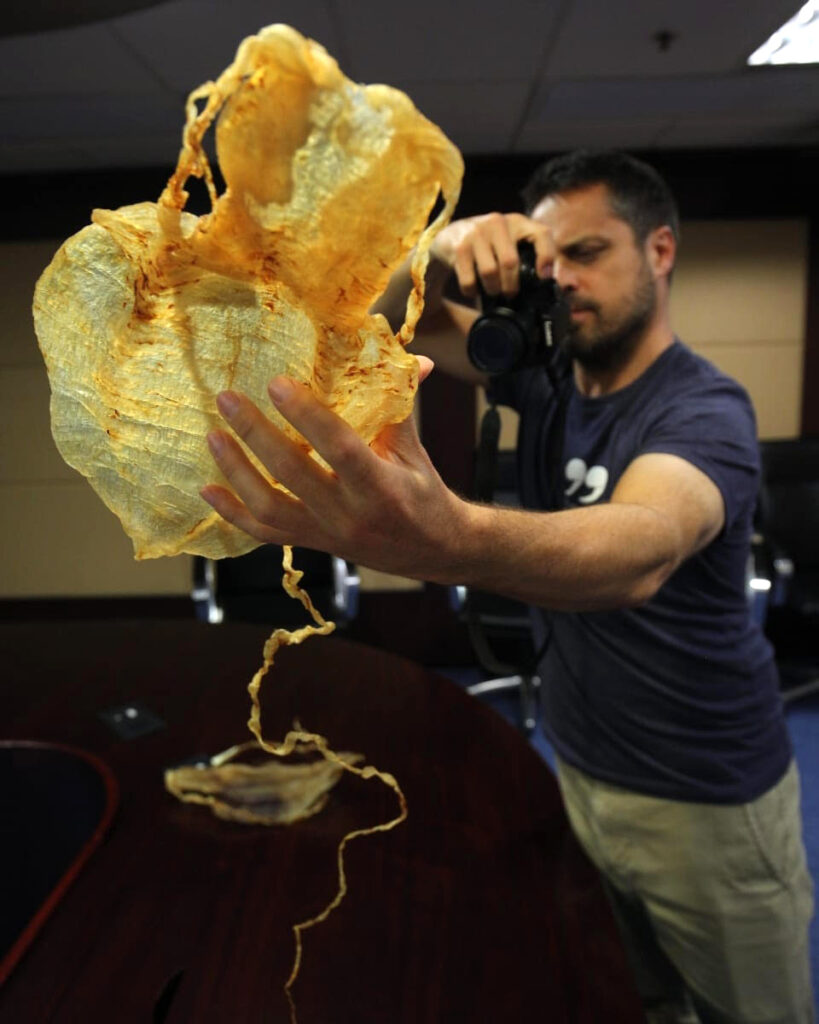
TOMASSONI: What is Operation Fake Gold and how has it helped to identify some of these major players in the illegal totoaba trade?
CROSTA: We launched Operation Fake Gold with the objective of identifying and investigating all the most important international totoaba traffickers in Mexico and push them out of the market. You remove the traffickers and the fishermen will stop fishing totoaba because nobody will buy them. We named it Operation Fake Gold because when we started the price of totoaba per gram was higher than gold. The price has since gone down. We deployed multiple undercover Chinese-speaking teams to infiltrate the traffickers’ lives, recruit sources and informants within the Chinese diaspora living in Tijuana and Mexicali and just across the border in the U.S. to better understand the supply chain, how and where totoaba is moved. Eventually, we expanded to other places like Mexico City and Baja, California.
We used hidden cameras to record many conversations and meetings. In one of the meetings we recorded in Mexico City, there were Chinese totoaba traffickers, big-time shark fin traffickers, a representative of the Sinaloa Cartel, and an immigration officer from the Mexico City International Airport, all sitting at the same table.
This story is funded by readers like you.
Our nonprofit newsroom provides award-winning climate coverage free of charge and advertising. We rely on donations from readers like you to keep going. Please donate now to support our work.
Donate NowTOMASSONI: Can you walk me through this supply chain—from the fishermen in San Felipe to the buyers overseas—and who’s involved along the way?
CROSTA: The illegal supply chain begins in the northern part of the Sea of Cortez, mainly around the two epicenters, the fishing villages of San Felipe and Santa Clara. It started years ago, almost by chance. In China, a fish very similar to the totoaba had gone extinct from overfishing, and its swim bladder was no longer available. My guess is that a Chinese trafficker in Mexico discovered the totoaba and realized it was almost identical and realized it could be extremely profitable. So did the fishermen. When I started looking into this, the average income a fisherman made was around $900 a month. By selling totoaba bladders, they could make thousands more. We’ve been told multiple times that only a minority of the fishermen decide not to get involved.
Once they catch the fish in the gillnets, they just eviscerate them on the boat, get the bladder and discard the carcasses at sea. That’s why if you walk along the beaches near San Felipe, you see all these carcasses of totoaba without the bladder.
Then the swim bladders are collected from the fishermen by local middlemen who transport the organs on ice to keep them fresh and store them in safe houses. From there, the product moves up the chain, often under the control of cartels, which have all gotten more involved in the last few years, Los Chapitos, which is a part of Sinaloa Cartel. They control San Felipe. They control fishing cooperatives. They control the whole thing. They make money out of the totoaba and also offer a kind of unmatchable protection to all those involved in the illegal operation.

TOMASSONI: Then, how do the bladders ultimately get to the buyers?
CROSTA: From the safe houses, the bladders are then dried so they don’t have to be refrigerated anymore and you can easily smuggle them around the world. Then, they usually use mules to smuggle the fish parts to other places. They’re using villagers and fishermen to smuggle the product. In one case, Mexican authorities discover a family, a father, mother, two kids driving with this gigantic, big bag full of bladders.
Then the bladders are smuggled out of Mexico to China, usually via other transit countries like the U.S., South Korea, Thailand, Vietnam and Cambodia. But a big, and more recent, development is that now we have a ton of evidence that there is an established and flourishing market in the U.S for totoaba. The U.S. is not anymore only a transit country. Now they buy here. One of our team members in Hong Kong was talking to a Chinese wildlife trafficker who said they couldn’t sell some of the most expensive totoaba bladders in Hong Kong anymore which go for $50,000 a piece. So, according to the source, traffickers sent the bladders back to the U.S where there was more of a demand.
TOMASSONI: How are the bladders sold in the U.S.?
CROSTA: It’s a completely underground market, of course. Traffickers have trusted customers around the US. We were told by sources that they were sending a lot of stuff to New York, for example, to individuals’ homes and hospitals where pregnant women were staying. Some buyers, we’re told, believe totoaba has health benefits for pregnant women.
TOMASSONI: Can you tell me about some of the major findings that have resulted from your investigation and how they’re being used to dismantle some of these criminal networks?
CROSTA: In total, we identified 23 different transnational trafficking networks involved in the totoaba trade and 300 persons of interest. We then handed this information to law enforcement. We’ve done it twice in Mexico, with the prosecutors, with the prosecutor in Mexico City.
In the last few years, we started to collaborate really closely with several U.S. law enforcement agencies, including Homeland Security Investigations. We would like to see these people arrested and prosecuted in the U.S., because you send a whole different signal to the rest of the traffickers. To date, two arrests of totoaba traffickers were made in San Diego about two years ago. We are working on additional arrests as we speak.
About This Story
Perhaps you noticed: This story, like all the news we publish, is free to read. That’s because Inside Climate News is a 501c3 nonprofit organization. We do not charge a subscription fee, lock our news behind a paywall, or clutter our website with ads. We make our news on climate and the environment freely available to you and anyone who wants it.
That’s not all. We also share our news for free with scores of other media organizations around the country. Many of them can’t afford to do environmental journalism of their own. We’ve built bureaus from coast to coast to report local stories, collaborate with local newsrooms and co-publish articles so that this vital work is shared as widely as possible.
Two of us launched ICN in 2007. Six years later we earned a Pulitzer Prize for National Reporting, and now we run the oldest and largest dedicated climate newsroom in the nation. We tell the story in all its complexity. We hold polluters accountable. We expose environmental injustice. We debunk misinformation. We scrutinize solutions and inspire action.
Donations from readers like you fund every aspect of what we do. If you don’t already, will you support our ongoing work, our reporting on the biggest crisis facing our planet, and help us reach even more readers in more places?
Please take a moment to make a tax-deductible donation. Every one of them makes a difference.
Thank you,


